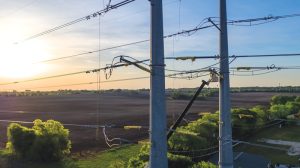“Come gather ’round people wherever you roam and admit that the waters around you have grown and accept it that soon you’ll be drenched to the bone. If your time to you is worth savin’, then you better start swimmin’, or you’ll sink like a stone for the times they are a-changin’.” – Bob Dylan
Times in the electric utility world seem to be more rapidly a-changin’ than ever before. Why you may ask, do I mention the electrical utility industry in STRUCTURE magazine? While it is obvious that Electrical Engineers are the beating heart (at 60 Hz) of the electric power grid, Civil and Structural Engineers add the bones and create the muscle that helps give the grid its strength, durability, and, dare I add, resiliency? The challenges facing the electric power grid are unique and unprecedented. As the Bob Dylan refrain elaborates, the waters of change are growing and we… better start swimmin,’ or you’ll sink like a stone!
Currently, there is much swimming like crazy to keep up with the changing times in this industry. I was honored to serve on ASCE’s Committee on America’s Infrastructure this past cycle. This Committee publishes a detailed progress report on various infrastructure segments every 4 years through its Infrastructure Report Card. The report card grade for the Energy Sector was raised last year from a D+ to a C-. The sector recommendations came with an acute recognition that the electrical power grid (not just in the USA but globally) has rapidly become the most critical of all societal infrastructures due to an increasing interdependency on electricity to function effectively. Disrupt the power for even a few days and see how long it takes before devastating effects are experienced. We only need to look back at the aftermath of recent extreme weather events like Hurricanes Katrina, Ike, Harvey, Ida, Sandy, etc., that significantly impacted the electrical grid to understand what a loss of electrical power means to civil society. Or ask the folks in Puerto Rico following Hurricanes Irma and Maria. Or study and report on the events leading to a near catastrophic grid collapse in Texas due to Winter Storms Uri and Viola as I did along with an incredibly talented group of Texas Section ASCE folks. Electricity ranks right up there with food, water, and shelter as a societal must-have.
To support improvement in structural reliability, ASCE/SEI is leaning in to develop critically essential and needed Standards and Manuals of Practice for the design and use of structures and foundations supporting the electrical power grid. This ensures that technical competence for the design, construction, and ongoing maintenance of these unique structural systems is continuously and professionally updated to meet the growing challenges in these rapidly changing times. One of the most important activities currently underway is the upgrade of the ASCE Manual of Practice No. 74 to a critically important new ANSI /ASCE Standard that will provide minimum loading criteria for the design of overhead powerline structures. It is a delicate but necessary task to balance current structure design loading practices diligently and effectively with new considerations to anticipate and mitigate the increasing impact of future severe weather events on our electrical grid.
And finally, ASCE/SEI has been an active and vocal advocate for nurturing and educating the civil/structural engineering professionals that contribute to making the electrical grid more reliable, durable, and, yes, more resilient well into the future. In October in Orlando, ASCE/SEI’s Committee of Electrical Transmission Structures (ETS) will host a specialty technical conference that has become globally recognized as a go-to event. The ETS Conference facilitates sharing knowledge and innovation for reliable and resilient design and construction of the structures and foundations that are the bone and muscle of the electric power grid – our transmission, distribution, and substation structures. See the SEI Update in this issue for more information.
The pace of change we will witness over the next few years will simultaneously be impressive and terrifying. Are we preparing for the changes on the horizon, and are we ready to lead the way to ensure the strength, durability, and resiliency of our critical electric power grid? The answer is YES! However, bring plenty of towels! We might be doing a lot of swimming as well!■
Infrastructure Report Card: https://infrastructurereportcard.org/cat-item/energy-infrastructure
Winter Storms Uri and Viola: www.texasce.org/our-programs/beyond-storms
Electrical Transmission & Substation Structures (ETS) Publications: https://ascelibrary.org/ets2020p?

